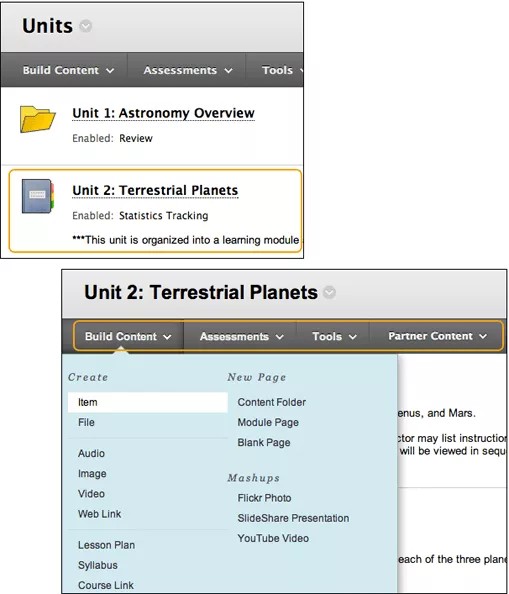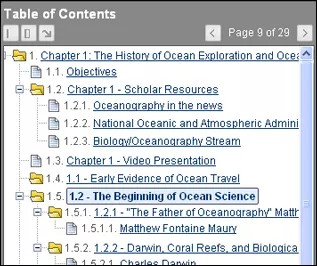Use learning modules to integrate related content and activities.
A learning module is a container for content that holds an organized collection of material presented with a table of contents. Typically, you create learning modules in content areas. You add and manage content in a learning module just as you do in a content area. You can add content items, file attachments, links to websites, tests, assignments, folders, and multimedia.
Use a learning module to support a course objective, concept, or theme. For example, use a learning module to present the concept of magnets' fields before you describe how speakers and microphones work. Understanding the first concept is dependent on understanding the second concept.
Alternatively, you can allow students to explore the content in a learning module in any order and at their own pace. For example, use a learning module to present a series of images and descriptions of various animals in a genus. Students can view the images and descriptions in any order as no order is required for understanding the whole.
Watch a video about learning modules
The following narrated video provides a visual and auditory representation of some of the information included on this page. For a detailed description of what is portrayed in the video, open the video on YouTube, navigate to More actions, and select Open transcript.
Video: How to add content to a learning module shows how to add content to a learning module, set options, and organize the table of contents.
Create a learning module and add content
Be sure Edit Mode is ON so you can access all of the instructor's functions.
Typically, you create a learning module in a content area > Build Content > Learning Module. Type a name, optional description, and select the appropriate options for availability, tracking, and display dates. Display dates don't affect a learning module's availability, only when it appears.
You select whether students will view the learning module's content in sequence. If you enforce sequential viewing, students must view the content in the prescribed order. You also determine if students will see a table of contents. You can select which labels to use for items in the table of contents: numbers, letters, Roman numerals, or mixed. If you select None, the items aren't labeled.
A newly created learning module is an empty container. Select the learning module in the content area to access it and create content. You can change the order of items with the drag-and-drop function or the keyboard accessible reordering tool.
As well as adding content items, files, and tests, you can add activities and tools that promote interactive learning and collaboration.
For example, you can add assignments or group projects to give students an opportunity to apply what they have studied in a learning module. Or, you can add collaboration tools, such as chat sessions and discussion board forums where students can brainstorm and share their ideas about the topics presented.
When you add new content in the learning module with a Display after date set within the next 20 minutes, select the 'Refresh' icon at the top right of the course menu. This way, your students will be able to access the new content at the scheduled time.
More on the types of content you can add
Learning module navigation
- Use the arrows to page through content sequentially.
- The table of contents displays the items you added to the learning module. Use the icons to move the table of contents to the bottom, expand, collapse, or remove it from view.
- Use the breadcrumbs to navigate to areas in the course you previously visited.
- The current content page appears highlighted in the table of contents and the available pages are links.
Add folders to learning modules
You can add folders to a learning module to organize content in the table of contents.
Each folder itself is a page in the learning module. You can provide a folder description so that the page doesn't appear blank to students who navigate through the learning module.
You can also nest folders to display many levels of content. Be aware that students have to navigate through the content in order if you set content to be viewed sequentially. Students must navigate through each folder, all nested folders, and the content within them before they can access the next item.
When you hide items in a table of contents, all nested items are also hidden. For example, if you hide a folder, then none of its content will be visible.
The image shows how nested folders appear to students in the table of contents.



